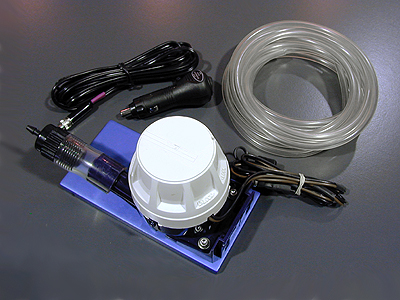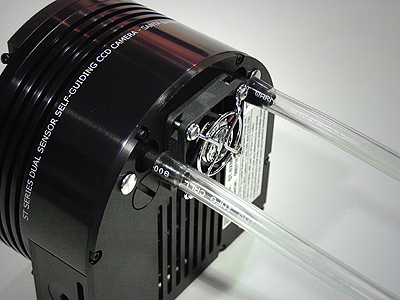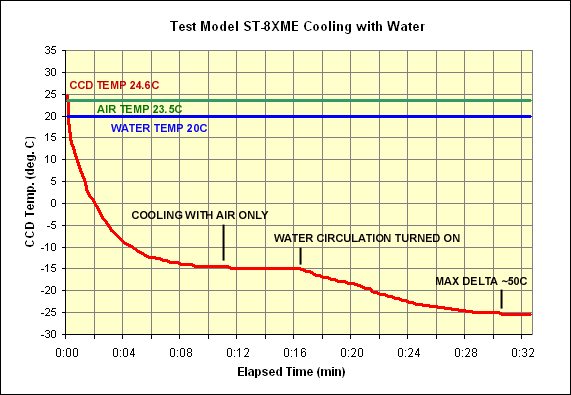12VDC Water Pump Kit
for ST and STL Cameras
August 14, 2008
 Using
water to improve the cooling of SBIG ST and STL cameras is simple and
inexpensive. These cameras generally do not require
more cooling than can be accomplished with air cooling alone, but there are
exceptions and if you happen to live in a very warm climate you may
wish to use the additional cooling that can be obtained with water circulation.
All dual sensor ST cameras are already equipped with a water circulation heat
exchanger inside the rear of the camera, ready for use. The only thing
that is required to use this feature is a supply of water.
Using
water to improve the cooling of SBIG ST and STL cameras is simple and
inexpensive. These cameras generally do not require
more cooling than can be accomplished with air cooling alone, but there are
exceptions and if you happen to live in a very warm climate you may
wish to use the additional cooling that can be obtained with water circulation.
All dual sensor ST cameras are already equipped with a water circulation heat
exchanger inside the rear of the camera, ready for use. The only thing
that is required to use this feature is a supply of water.
Obtaining optimum cooling in hot weather using water
circulation requires very little in the way of water pressure or chilling of the water
to get the most cooling performance from your camera. You can do quite
well with water that is just below ambient temperature. Chilling the water
further can help but care
must be taken not to chill the water below the dew point or condensation may
form in you camera. Fortunately, it takes very little chilling, if any, to
obtain more cooling than you will need for most circumstances, and a slow steady
flow of water is all that is necessary. Many users do not use water
circulation at all. If, however, you image on very warm nights and want to
get the most cooling you can get, our 12VDC water pump kit includes everything
you will need to achieve sufficient cooling for any climate. The kit
includes a 12VDC water pump mounted on a thick anodized aluminum plate so the
pump can simply be placed at the bottom of an reservoir of water without further
attachment. The pump's power cord terminates in a cigarette lighter
adapter plug for convenient use in a variety of field power supplies. The
plug has a convenient on/off switch on the back. In the alternative, this
plug can be removed and the cable attached directly to a 12V battery. The
connector at the pump can also be used with an optional universal 100- 240VAC to
12VDC power supply (the same power supply we use for the ST-402ME camera).
 The
setup is simple. Just push each of the two supplied tubes over the water
connectors on the back of the camera. Connect the other end of one of the
tubes to the pump. The end of the other tube will just lay in the water
reservoir for returning the water from the camera. Fill a
reservoir with some water at ambient temperature or a few degrees below ambient.
Place the pump in the water and plug it in.
The
setup is simple. Just push each of the two supplied tubes over the water
connectors on the back of the camera. Connect the other end of one of the
tubes to the pump. The end of the other tube will just lay in the water
reservoir for returning the water from the camera. Fill a
reservoir with some water at ambient temperature or a few degrees below ambient.
Place the pump in the water and plug it in.
 The graph at
right shows the results of a random test performed on a
stock ST-8XME camera pulled from the shelf. The camera was set
up with water circulation ready, but the pump was off. The reported
temperature of the CCD at the start of the test was just under 25 degrees C.
The room temperature was
reading 23.5 (+/- 1.5 degrees). The camera was first cooled to the maximum
it would reach with air only then the water pump was
turned on and the camera allowed to cool further until it leveled out at -25.4 C, or
a delta of approximately -50 degrees C. at 100% TE cooler power. At 86%
power to the TE cooler, with water circulation, the camera would regulate the cooling at -22 C, or a delta of about -47 C.
This is with water at just a few degrees below room temperature, 20C or about
68F.
The graph at
right shows the results of a random test performed on a
stock ST-8XME camera pulled from the shelf. The camera was set
up with water circulation ready, but the pump was off. The reported
temperature of the CCD at the start of the test was just under 25 degrees C.
The room temperature was
reading 23.5 (+/- 1.5 degrees). The camera was first cooled to the maximum
it would reach with air only then the water pump was
turned on and the camera allowed to cool further until it leveled out at -25.4 C, or
a delta of approximately -50 degrees C. at 100% TE cooler power. At 86%
power to the TE cooler, with water circulation, the camera would regulate the cooling at -22 C, or a delta of about -47 C.
This is with water at just a few degrees below room temperature, 20C or about
68F.
It should be noted that the cooling performance can vary from
camera to camera, and this is a single test. For this reason we state that
the "typical" cooling performance of an ST camera is -35 degrees C below ambient
with air only and -45 degrees C below ambient with water. This is more
than enough cooling
to reduce the dark current noise of any ST camera well below the sky background noise in the vast
majority of cases, even when using narrowband filters, on warm summer nights.
As of the date of this announcement (8/14/08) the 12VDC water
pump kit list price is $129 but is being offered for free with new self-guiding
ST cameras as part of a special
offer. SBIG also offers a
smaller pump that is powered by 110VAC (only) for ST cameras for $49. Please
see our Price List for current prices.
Revised:
August 14, 2008 10:18:27 AM.
Copyright © 2008 Santa Barbara Instrument Group, Inc. All rights reserved.
Please report any problems with this page directly to the Webmaster
 Using
water to improve the cooling of SBIG ST and STL cameras is simple and
inexpensive. These cameras generally do not require
more cooling than can be accomplished with air cooling alone, but there are
exceptions and if you happen to live in a very warm climate you may
wish to use the additional cooling that can be obtained with water circulation.
All dual sensor ST cameras are already equipped with a water circulation heat
exchanger inside the rear of the camera, ready for use. The only thing
that is required to use this feature is a supply of water.
Using
water to improve the cooling of SBIG ST and STL cameras is simple and
inexpensive. These cameras generally do not require
more cooling than can be accomplished with air cooling alone, but there are
exceptions and if you happen to live in a very warm climate you may
wish to use the additional cooling that can be obtained with water circulation.
All dual sensor ST cameras are already equipped with a water circulation heat
exchanger inside the rear of the camera, ready for use. The only thing
that is required to use this feature is a supply of water.  The
setup is simple. Just push each of the two supplied tubes over the water
connectors on the back of the camera. Connect the other end of one of the
tubes to the pump. The end of the other tube will just lay in the water
reservoir for returning the water from the camera. Fill a
reservoir with some water at ambient temperature or a few degrees below ambient.
Place the pump in the water and plug it in.
The
setup is simple. Just push each of the two supplied tubes over the water
connectors on the back of the camera. Connect the other end of one of the
tubes to the pump. The end of the other tube will just lay in the water
reservoir for returning the water from the camera. Fill a
reservoir with some water at ambient temperature or a few degrees below ambient.
Place the pump in the water and plug it in. The graph at
right shows the results of a random test performed on a
stock ST-8XME camera pulled from the shelf. The camera was set
up with water circulation ready, but the pump was off. The reported
temperature of the CCD at the start of the test was just under 25 degrees C.
The room temperature was
reading 23.5 (+/- 1.5 degrees). The camera was first cooled to the maximum
it would reach with air only then the water pump was
turned on and the camera allowed to cool further until it leveled out at -25.4 C, or
a delta of approximately -50 degrees C. at 100% TE cooler power. At 86%
power to the TE cooler, with water circulation, the camera would regulate the cooling at -22 C, or a delta of about -47 C.
This is with water at just a few degrees below room temperature, 20C or about
68F.
The graph at
right shows the results of a random test performed on a
stock ST-8XME camera pulled from the shelf. The camera was set
up with water circulation ready, but the pump was off. The reported
temperature of the CCD at the start of the test was just under 25 degrees C.
The room temperature was
reading 23.5 (+/- 1.5 degrees). The camera was first cooled to the maximum
it would reach with air only then the water pump was
turned on and the camera allowed to cool further until it leveled out at -25.4 C, or
a delta of approximately -50 degrees C. at 100% TE cooler power. At 86%
power to the TE cooler, with water circulation, the camera would regulate the cooling at -22 C, or a delta of about -47 C.
This is with water at just a few degrees below room temperature, 20C or about
68F.